Convector heating at home: how to heat the cottage quickly
Many people mistakenly believe that the use of separate heating elements - convectors - is not able to provide heating at home to a comfortable temperature and in vain prefer more difficult to install climate control systems. Meanwhile, these devices are perfect for the equipment of a small country house or summer cottage. We will understand in more detail what convector heating is and what are its advantages.
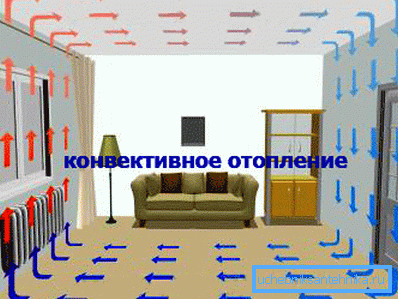
Use of convectors
Basic concepts
The convector is a device that performs heating of the room due to the circulation of cold and hot air masses in it. When arranging such a heating scheme, there is no need to install a central boiler, radiators and pipelines moving the heated coolant.
Air convectors have many advantages:
- easy to install and maintain - the installation and commissioning procedure can be easily done by hand, which cannot be said about water heating with a gas boiler;
- easy to operate - for work, you just need to turn on the convector and select the desired temperature, the electronics built into the device will do the rest;
- have low inertia - just a few minutes after switching on, the convectors will warm the room to the desired temperature.
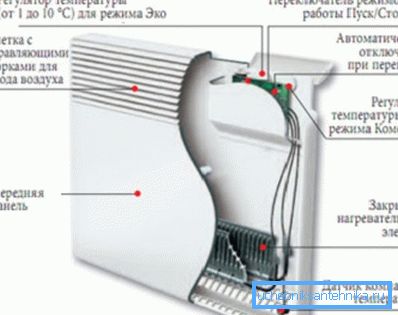
Tip! Convector heating of a summer cottage is most effective, where there is no all-year-round living provided for people Arriving in the country and turning on the equipment, you quickly heat all the rooms. In addition, this prevents the water in the pipes from freezing when the heating is turned off.
As an energy carrier can be:
- electricity;
- liquefied gas supplied in cylinders.
Many believe that individual convectors are not able to provide comfort and coziness in the room. However, in this case we are talking only about devices equipped with ultraviolet or infrared heating elements. They only heat items that are in their area of operation, ignoring the rest of the room.
In contrast, gas convectors and electric heaters with heating elements increase the temperature of the air, forcing it to circulate around the room, heating the latter.
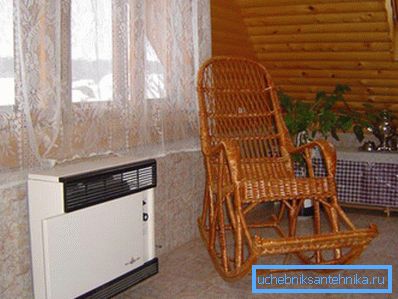
Heat fans work even more efficiently, but the noise accompanying their work does not contribute to a pleasant rest.
Features of convector heating
The following instruction will help to achieve the greatest effect when arranging the heating of a dwelling with the help of convectors:
- Before installing the heating equipment, it is advisable to carry out measures to warm the home - install heat insulating materials on the walls, floor and roof;
- for heating the room requires 1 kW of energy per hour per 10 square meters. square meters (plus a small margin for heat loss) - based on this calculation, and you need to purchase equipment.
Tip! Buy convectors equipped with thermostats. In this case, the power of the device will vary depending on the ambient temperature. So you can not only achieve maximum comfort, but also save money on electricity or gas, the price of which is quite high.
Gas convectors
The principle of the unit
The scheme of the gas convector is as follows. Liquefied natural gas is burned in a special chamber, giving its energy to the heat exchanger. The latter heats the air entering through the lower air vents.
The density of heated air masses decreases, as a result of which they rise up. So there is a gradual replacement of air and its heating, due to which the rooms are heated.
Some models have a fan that speeds up circulation. Its use is not always justified, as the noise generated by an electric motor often causes discomfort.
The design of the gas convector requires a channel that must go out. It is necessary to remove combustion products from the room and to draw in fresh air used in the work. The coaxial pipeline, which is laid in the thickness of the wall directly near the place of installation of the convector, acts as a chimney.
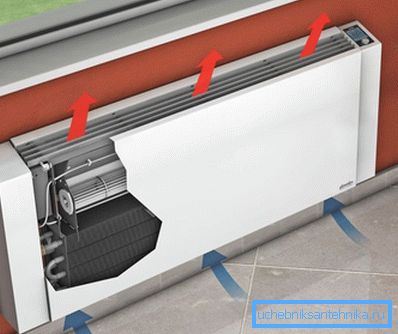
Equipment selection
The gas convector is a direct competitor to the boiler operating on the same type of fuel. The use of the latter is justified in the case when it is necessary to constantly heat a large area of a house or building with more than 3-4 rooms. Only in this case can the capital costs of installing radiators, pipelines and the boiler itself be considered justified.
Otherwise, it is advisable to opt for the convector. Especially effective is the use of this equipment in the country, where people do not live permanently.
Choosing one or another model of a gas convector, pay attention to the following design features:
- Heat exchanger material. There are varieties made of cast iron and steel. The first option has a higher efficiency, but also more inertia. That is, this device will heat the room longer, and the heat generated by it will persist for a longer period of time from the moment the gas is turned off.

The disadvantages of cast iron convectors can be attributed to their large weight and relatively high cost. However, their service life is much longer than the period of operation of steel devices.
- The presence and design of the pipe. Many modern gas convectors are equipped with telescopic coaxial channels, allowing you to adjust the length depending on external conditions. In addition, these chimneys differ in diameter, which depends on the power of the convector. Choose models with pipes, the end of which is protected by a decorative nozzle. It will give the cut a more attractive appearance and protect it from debris, precipitation and foreign objects.
- The combustion chamber. Can be closed and open. The closed combustion chamber is used in most cases. An open flame convector can be used to replace a morally obsolete furnace in the country. In this case, the products of combustion are discharged through the chimney.

Note! Convectors with an open combustion chamber burn oxygen present in the room. Therefore, it is necessary to take measures for additional ventilation, otherwise it will be uncomfortable to stay in the room.
Electric convectors
Benefits of using
The principle of operation of electric heating equipment is similar to gas. But to heat it, it uses electricity, not liquefied gas.
The advantages of using electroconvectors are obvious:
- safety of operation - the heating element raises the temperature of the heat exchanger to the mark of + 60 degrees Celsius, which makes it impossible to get a burn when touched;
- efficiency - the presence of special thermostats that increase or decrease the power of the device, makes it possible to significantly reduce the amount of electricity used while maintaining a comfortable air temperature;
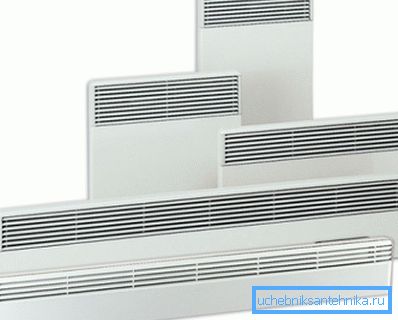
- low inertia - thanks to a special heat exchanger, the electric convector of heating quickly raises the air temperature in the room without requiring forced circulation of air masses;
- ease of installation - heating equipment does not require a pipeline to supply coolant or remove combustion products, therefore it can be installed in any place where there is access to an electrical outlet.
Types of construction
Depending on the interior of the room, the area of the room and other factors, you can choose and install electric convectors of the following types:
- Wall mounted - mounted on a vertical plane with the help of brackets.
- Floor - installed anywhere on the room on the legs or rollers.

- Plinth - placed along the walls, used for heating rooms with windows reaching the floor.

- Universal - thanks to the special design of fasteners can be placed on the floor or hung on the wall.
Conclusion
After reading the article, you were able to independently verify that heating, organized with the help of convectors, is not the worst, and sometimes even more acceptable, solution to the issue of heating the rooms. You can learn more about the climate control equipment from the video posted in this article.